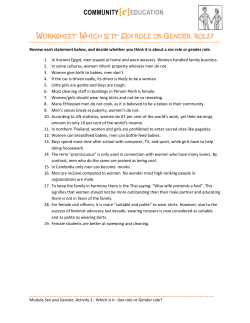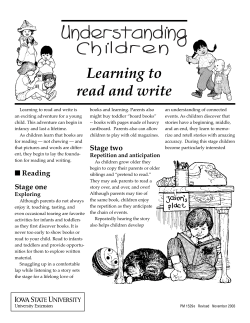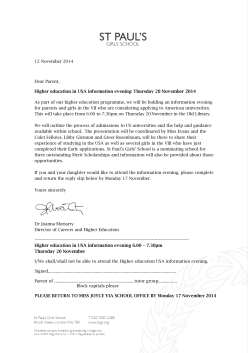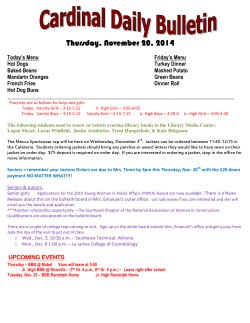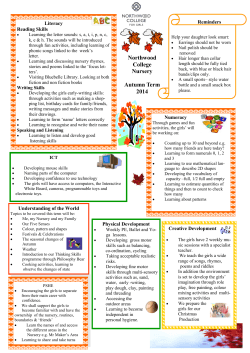
Women and the Media: Who do they think you are?
Department for Communities e? Women and the Media: Who do they think you ar Minister’s Message The portrayal of women in the media is an issue of growing concern. The world of mass media and its role and influence in our lives is increasing at a rapid pace. The representation of women in the media is a focus of the Department for Communities, Women’s Interests Strategic Directions 20112014. This is an issue critical to women’s safety, health and wellbeing. I hope this discussion paper will fuel debate about the way women are (and aren’t) portrayed in the media, to help encourage critical thinking by all of us when we engage with the media throughout our daily lives, and to offer people some tools to improve the situation. I encourage you to take the ideas from this paper and start conversations with your friends and family about this critical issue. Hon Robyn McSweeney MLC MINISTER FOR CHILD PROTECTION, COMMUNITY SERVICES, SENIORS AND VOLUNTEERING, WOMEN’S INTERESTS, YOUTH. Government of Western Australia Department for Communities Women’s Interests Media portrayals of women-what are they doing to women and men? The mass media – television, internet, radio, newspapers, magazines and film – is part of our everyday life. It is a powerful tool that provides us with information and entertainment. It reflects our society and it influences the way we think. The demonstrated gender inequality in the media has significant consequences. Media affects our ideas of who we are and what we could be. We create our identity in relation to the images we see around us from a young age. The current widespread access to media’s limited representations of gender can have undesirable effects. When people are repeatedly shown images of women as victims, sexualised, or in domestic roles, they are more likely to accept these images as normal. When women are portrayed as passive, dependent or weak, it can seem unusual for them to be active, independent or powerful in society. This can affect both men’s and women’s ideas about which careers women might be good at, how important it is for women to be sexually attractive, and whether women should be in positions of authority. The media has been criticised for its portrayal of women as objects whose value is measured in terms of their usefulness to others. It becomes difficult to see them as thinking, feeling, capable people. Constantly portraying women in a highly sexualised way makes it more likely all women will be seen as sexual objects. This then becomes a human rights issue. For example, in Western Australia 92.3% of sexual assaults are committed against women. Page 1 | Women and the Media: Who do they think you are? Research has found... The American Psychological Association’s Taskforce on the Sexualisation of Girls found that media sexualisation of girls and young women is linked to mental health problems including depression, anxiety and eating disorders in women.¹ The dangerous consequences of objectifying women are also highlighted by Dr Jean Kilbourne who notes that, “turning a human being into a thing is almost always the first step in justifying violence against that person”.² A key criticism of media portrayals of women is that they reinforce negative stereotypes. There is a distinct lack of positive role models for women and girls in music videos, magazines, adverts and movies. Due to the widespread access to media in our society most people are constantly being exposed to skewed representations of gender. These portrayals are repeated thousands of times in the average person’s life. Women’s magazines are filled with advice on dieting, sex tips, fashion and the positioning of the body as the most important part of a woman’s life. The increasing use of Photoshopped images in these magazines adds to unrealistic perceptions of what women look like. Snapshot 1 women’s magazines for We looked at two leading a total of 14 story titles the month of October. Of the topic of sex and 4 on their covers, 5 were on one headline was about were about fashion. Only health. What do these career and one concerned rtant to women? magazines tell us is impo Image courtesy of Cleo Magazine, ACP Magazines n of Cosmopolita Image courtesy Magazines CP A Magazine, Research has shown that exposure to idealised images of women in magazines has negative effects on their self-esteem: a study in the Psychology of Women Quarterly found, “Women often feel dissatisfied with their appearance after comparing themselves to other females who epitomize the thin-ideal standard of beauty”.³ Women’s increased risk of sexual assault, domestic violence, and mental health problems, alongside the barriers they face to achieving leadership roles in employment and equal pay clearly indicate that women experience inequality in our community. The media is contributing to values that support these inequalities. While there are complex reasons for these real-life situations, it is a concern that the media promotes values that perpetuate this inequality. ¹ 2007 - www.apa.org/pi/women/programs/girls/report ² “Media Education Foundation Study Guide: Killing us Softly 4: Advertising’s Image of Women” by Kendra Hodgson. www.mediaed.org/ wp/study-guides ³ Evans, Peggy Chin. “If Only I Were Thin Like Her, Maybe I Could be Happy Like Her”: The Self-Implications of Associating a Thin Female Ideal with Life Success.” Psychology of Women Quarterly 27.3 (2003): 209. Snapshot 2 In the past few years increasing concerns have been raised about the sale of t-s hirts which display sexually provocative ima gery of women… Have you seen these shirts when you are out in public? What has been your rea ction to them? Do you see similar shirts with me n displayed in this way? Images courtesy of City Bea ch Australia Page 2 | Women and the Media: Who do they think you are? Women in movies ngs from In a study of top films across all rati racters were 1990 to 2006, 73 per cent of the cha ales did men. The proportion of males to fem not change in this 16-year period. 6–2009, In a study of all G-rated films from 200 le and 80.5% of working characters were ma 19.5% were female. e no The same study also found there wer in medical representations of women working itics. science, executive business, law or pol Be the media analyst: ask yourself these questions •How many female characters are there compared to male characters? •Is the focus on women’s bodies or on their characters, achievements or jobs? •Are women shown as victims of violence? •Are any female characters leaders – such as political leaders, business professionals, employers, or other positions of authority? •Does the absence of women in these roles in film and television shows affect women’s roles in the real world? Research has found •Women and girls appear les s frequently than men and boys in the mass me dia and when they do appear, they speak les s. •There is more focus on wome n’s appearance, with the ‘ideal’ woman often depicted as extremely thin. •Women are also more likely to be shown in ways that focus on sexual ava ilability, passiveness, and dependence on other people – they are motherly or domesti c, sexualised, or too often represented as vic tims. •Even when women are portra yed in active roles, they are often cast with hypers exual characters. Bechdel Movie Test The Bechdel Test is us ed to identify gender bias in films. See how man y movies you know th at can pass the Bechdel Movie test by answer ing ‘yes’ to these three qu estions: - Are there two or mor e women in the movie with names? - Do they talk to each other? - Do they talk about something other than a man? A movie passes if you can answer yes to all three – even if it is only one scene that passes. Give your opinion on this year ’s films at bechdeltest.com. 2012 Movies es, The Bourne Legacy, Passed: The Hunger Gam Dark Shadows Rises, The Avengers, Failed: The Dark Knight The Amazing Spiderman In news media A study of Australian media in November 2009 found that only 24% of peop le who were heard, read about or seen in news sto ries were female. In spo rts sto ries this figure fell to 1%. Of the 24% of females in news stories, 44% were victims of crimes, accide nts, war, health problems or discrimination. Family status (mother, daughter, wife, sister, or other family relationship) was mentioned for 33% of women quoted or dis cussed in the news stories. Only 13% of men had their family status mentioned. In 75% of news articles women were described as homemakers or parents. Only 32% of the stories were presented or written by female reporters an d newsreaders. Page 3 | Women and the Media: Who do they think you are? You can’t be what you can’t see-where are the role models? For the last decade women have outnumbered men in higher education but in Australia’s top ASX 200 companies: •Only 3 per cent of Chief Executive officers are women. •Only 8 per cent of Board Directors are women. Nationally, women’s average earnings are 18 per cent less than men’s. In WA the figure is 28 per cent. •Women more often work in areas that pay lower wages. •Women occupy less senior positions and take more time out for family responsibilities. Be the media analyst represent female - How does the mass media wer? politicians and women in po featured in the - What types of women are r each day? evening news and in the pape een the ways - Is there any difference betw vertising media women are represented in ad h as movies or TV? and entertainment media suc References Gender Stereotypes: An Analysis of Popular Films and TV, The Geena Davis Institute on Gender in Media www.thegeenadavisinstitute.org/research/ Romano, Angela R. (2010) Australia:Global Media Monitoring Project 2010 National Report. GMMP: Toronto, ON Canada. Occupational Aspirations: What are G-rated films teaching children about the world of work? www.apa.org/pi/women/programs/girls/report.aspx Media Education Foundation Study Guide: Killing us Softly 4: Advertising’s Image of Women by Kendra Hodgson. http://www.mediaed.org/wp/study-guides Australian Bureau of Statistics, 2004, Sexual Assault in Australia: A Statistical Overview ABS 4523.0. Women’s Report Card: WA Police Business Analysis and Evaluation Unit. WA Police Frontline Management System (IMS) and Offence Information System. Customised Data. 2012 Department of Training and Workforce Development, VET Enrolment Statistics Unit. Customised data, 2012. Take action Media is a business. It is sensitive to the responses and buying patterns of its consumers. Ratings are very important to television stations and programmes are often dropped if they don’t rate well. You do have a say. • Tell the media – send feedback; write letters to editors and comment online. •Complain – the Australian Communications and Media Authority, the Australian Press Council, Independent Media Council and the Advertising Standards Board are waiting to hear from you. Visit www.acma.gov.au. •Do it yourself or find alternatives – talk on your own blog, videos or zines. •Tell your friends – use social media, Facebook and Twitter to get people thinking, boycotting and complaining. Big companies monitor social media so it’s a good place to get heard. •Feed good news stories to the media – contact your local media if you have good news stories about women, and if there is a photo opportunity, it’s even better. •Join or support a lobby group – www.collective.shout.org uses online forums to help women take action. •Talk to men – It is well evidenced that the media portrayal of women as either sexualised or insignificant is targeted mainly at male consumers. Men need to let media know they want respectful representations of women as equals. •Tell the company, boycott the product – Let companies know you aren’t happy, and why; use social media or write on their Facebook page. For more information For more information on how the Department for Communities is supporting women’s interests visit: www.communities.wa.gov.au. Page 4 | Women and the Media: Who do they think you are?
© Copyright 2025

